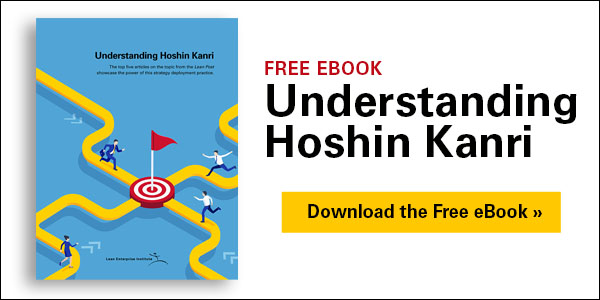For many years, I have watched organizations attempt to implement hoshin planning (strategy deployment, if you prefer). First, they pick a few big issues important to the long-term success of the organization — a leap in quality, a dramatic drop in costs, a reduction in lead time to better meet customer demand, a fundamental rethink of the type of value the organization creates for customers. And then, they try to deploy initiatives to address these issues down through the levels of the organization. But even when they limit the initiatives to a small, manageable number, they rarely succeed.
What starts with the loud voice of the CEO at the top becomes a faint whisper by the time it reaches the organization’s front lines, where value of whatever description is created and where improvement becomes real. At this level, managers are mostly absorbed with daily chaos, with no workable method for addressing hoshin objectives even when they are clearly stated and prioritized for that level.
How Toyota Cascades Hoshin
Recently, I had the opportunity to closely observe hoshin planning at Toyota, which has developed the management mechanisms necessary to translate high-level hoshin plans into sustainable results on the front lines. Let me describe what I’ve seen.
Toyota has developed the management mechanisms necessary to translate high-level hoshin plans to sustainable results on the front lines.
Toyota President Akio Toyoda and the senior leadership team have decided that the simultaneous emergence of autonomy, alternative energy, shared assets, and hyper-connectivity is collectively creating a “once-in-a-century disruption” in the auto industry as it transitions to a mobility industry, commonly termed Mobility 2.0. (Whether this is true or not is a separate question, although every other legacy car company has reached the same conclusion. My point here is about the successful deployment of hoshin, not the validity of the hoshin vision.) And recently, Toyota has had to add an extra dimension to the challenge: uncertainty about global trading rules, which might require substantial relocation of existing production, with loss of revenue and increased costs.
Because many things are changing at once and the right path to follow for each dimension of the Mobility 2.0 challenge (plus the changing rules of trade) is impossible to know, Toyota is responding by extending its principles of concurrent engineering with set-based design from individual vehicles to whole mobility systems. For example, it is experimenting with:
- Level 4 autonomy, where vehicles drive themselves, and Guardian, a system that leaves driving to the driver but prevents the driver from making dangerous mistakes.
- Electric vehicles with pioneering solid-state batteries and hydrogen fuel cell vehicles.
- Partnerships with ride-hailing firms and logistics firms like Uber and Amazon and experiments with Toyota fleets of shared, autonomous vehicles (to be showcased at the 2020 Tokyo Olympics).
- Toyota Connected for connectivity between vehicles, passengers, and their environment and partnerships with other connectivity providers.
And, perhaps most interesting, they’ve initiated a major push to apply Toyota Production System (TPS) principles to the development of the enormous software packages needed for each of these innovations.
So the primary strategic hoshin of “address the once-in-a-century-disruption of the automotive industry” needs a companion operational hoshin of “create the financial resources to support the respond-to-disruption hoshin.
Many of these experiments may fail. And, even if a number of the concepts prove worthy of widespread adoption, Toyota must expend massive sums now for lengthy experiments to determine which work best while defending its current employees, always a core Toyota principle. So the primary strategic hoshin of “address the once-in-a-century-disruption of the automotive industry” needs a companion operational hoshin of “create the financial resources to support the respond-to-disruption hoshin.”This cascading of the strategic hoshin to an operational hoshin at the value-creating front lines provides the critical means to a vital strategic end — that’s hoshin done right.
The specific means were recently visible to me on the shop floor at Toyota Kyushu’s Miyata assembly plant on the southern Japanese island of Kyushu. (This plant assembles Lexus vehicles.) The hoshin objective that came down to the plant for this year is a target to substantially reduce costs while accommodating a richer model mix while reducing takt time to meet increased demand (with substantially no capex) while sustaining assembly quality at the current level, which is reported by J.D. Power and Associates to be the highest in the world.
To be clear: This objective means increasing the production rate with no capital spending while sustaining world-best quality and reducing the number of workers required on the line (more on that in a moment). Thus, it will save money that will be used for experiments with Mobility 2.0. And these experiments will permit Toyota to survive and defend jobs in the long run. Wow. This is big. And it’s complicated. How exactly to do this?
Understanding the Background for the ‘How’
The Miyata plant has a very mature lean production system that has created basic stability: the production line runs more than 98% of the time, with about 1,000 Andon pulls per day in final assembly. Almost all of these are addressed by team leaders within takt time to steadily produce good vehicles with very little rework. This stability means, in turn, that managers are not bogged down in fire-fighting and have time available to think about improvements in the context of hoshin targets.
The plant is facing a labor shortage that is certain to become more severe every year as the Japanese population falls steadily due to the very low birth rate and the country’s unwillingness to depend on guest workers. So eliminating jobs on the line while defending the current workforce is both necessary and easily addressed by not hiring replacements for retirees.
Finally, the stable workforce — including the frontline production associates — has been trained for many years in troubleshooting (to keep production going with short-term countermeasures), problem-solving (to eliminate repeat problems), kaizen (to raise the production standard), and Jishuken (to learn by doing). The latter is a special type of hands-on, learn-by-doing kaizen workshop designed to develop the skills — especially Toyota Production System and problem-solving skills — of associates within an entire production activity, e.g., a value stream, production line, or department, over an extended period (perhaps three months). The goal of any jishuken is to learn by doing and improving an area of operations. In the context of hoshin, managers lead their associates in rethinking and solving problems in every aspect of their work as they strive to achieve their hoshin goal.
Now let me introduce the Jishuken team I recently met, working on one portion of the Miyata final assembly line — one of many similar teams on every portion of the line and in other areas across the plant). The group leader and the four direct-report team leaders for this portion of the line had worked for three months to redesign every job and improve many pieces of equipment using Karakuri principles. (See Matt Savas’ Lean Post, Developing People Not Robots Through Karakuri.) Their objective was to achieve their clearly stated hoshin goal.
(I would love to provide the particulars — the substantial reduction in takt time, the minimal capital spend, the positive consequences for quality, all of which were very impressive. And I also would love to provide photos of the many ingenious Karakuri devices built by the team. But I was at Miyata as a guest to learn, not as a journalist to share the details of their detailed business plans with the world.)
An explanation of what they had done made a nice presentation in a team room. But the Jishuken team’s work really came alive when I visited their portion of the line to see in detail what they had done. I have never observed detailed kaizen at this level of intensity (on a production process that was already one of the best in the world). More impressive to me, it was conducted by the front two levels of line management — team leaders and the group leader rather than staff experts — in collaboration with the twenty or so production associates, with an amazing level of engagement. They could hardly stop talking about what they had achieved and showing the ingenious, low-cost tools, fixtures, and materials presentation devices they had built and installed.
These types of efforts have been underway at Toyota facilities across the world for several years as the company continues to build its war chest for the challenge of disruption. (See CEO Akio Toyoda’s comments accompanying the release of this year’s financial results on May 9. They are a remarkably sober and focused discussion of Toyota’s circumstances and hoshin plans despite its record sales, earnings, and cash balance.)
Is this cost-reduction effort, enabling an extraordinary range of experiments, enough for a massive legacy company to survive a once-in-a-century disruption? Or is the perceived disruption a misunderstanding of the situation, a mirage? Who knows. What I do know is that the methods I saw at Miyata for deploying hoshin down to the front lines offer an important lesson for all of us in the Lean Community as we try to cascade our own hoshin plans down to the point of value creation where they become truly useful.
P.S. A brief glossary of terms used in this piece:
Andon – A visual management tool that highlights the status of operations in an area at a single glance and that signals whenever an abnormality occurs (from Lean Lexicon)
Karakuri – A method of kaizen that employs simple apparatus, such as pulleys and counterweights, while prohibiting the use of hydraulics, robotics, and electricity.
Jishuken – A type of hands-on, learn-by-doing kaizen workshop directed by management and designed to develop the skills — especially Toyota Production System and problem-solving skills — of associates within an entire production activity, e.g., a value stream, production line, or department, over an extended period (perhaps three months). The goal of any jishuken is to learn by doing while improving an area of operations. The term “jishuken” translated to English means “self-learning.”
Managing on Purpose with Hoshin Kanri
Learn how to develop strategy and build alignment.






I had met some of Japanese company applied “Jishuken”, but not entirely impact to their organization, as this program is lead by manager with a engineering team who support frontline. Not direct involvement of front line associates. That is a challenge to discover a hidden risk or new emerging risk of Quality.